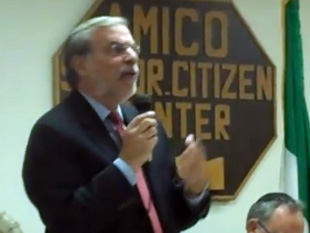Assembly Member Dov Hikind is stooping to a new low, even by Albany's standards, to ensure that traffic keeps on menacing pedestrians to the fullest extent possible on NYC streets.
The central Brooklyn rep announced today that he's trying to force the Department of Transportation to remove pedestrian refuges from Fort Hamilton Parkway, threatening what looks to be a copycat lawsuit modeled after the anti-bike lane case filed by well-connected opponents of the Prospect Park West redesign.
Hikind's office says he plans to file the lawsuit in the next 10 to 14 days, under the same state provision, known as article 78, employed by the PPW plaintiffs.
The Fort Hamilton Parkway refuges were installed last year as part of DOT's citywide effort to improve street safety in areas with high proportions of senior pedestrians. The project [PDF] targeted a stretch in Borough Park with a grisly record of traffic violence, as local City Council Member Brad Lander wrote in the neighborhood newspaper Hamodia last fall:
On December 31st, 2009, a 74-year-old woman was hit by a truck and killed as she crossed Fort Hamilton Parkway at 49th Street in Boro Park. In April of this year, a 55-year-old person was killed crossing Fort Hamilton just a few blocks away. Nearby, several other pedestrians have been struck by cars. In 2008, when a car collision at Fort Hamilton and 44th Street killed two people, a local resident called it the “corner of death.”
Hikind's announcement omits all mention of these fatalities. In a press release replete with scare quotes around the phrase "senior safety," his office announced the delivery of 1,100 petitions to DOT Brooklyn Borough Commissioner Joseph Palmieri seeking the removal of the refuges. Hikind characterizes the refuges, which give pedestrians safer crossings and cause drivers to take turns more carefully, as "absurd islands." A project to prevent deaths and injuries is, in Hikind's view, part of "Sadik-Khan’s crusade against vehicles and motorists.”
Hikind, repeating arguments from a rant he delivered at Brooklyn Community Board 12 last year, hides behind a familiar argument against traffic calming projects all over the country: that streets designed to improve safety impede emergency response, in this case for vehicles en route to Maimonides Medical Center. Streetsblog noted in December that these claims are divorced from public health and safety research, which show that life-saving benefits accrue from traffic-calming, while no correlation exists between patient mortality rates and the time it takes to transport patients to a hospital. From a safety perspective, there is no reason to think that a Fort Hamilton Parkway without pedestrian refuges would do anything except put people at greater risk.
As Traffic author Tom Vanderbilt has written, using the emergency response argument against traffic calming measures entails a fundamental miscalculation:
Designing roads to meet some supposed emergency response criteria, for that dramatic last-second rescue, actually helps raise the risk of dying in a much more common way: In traffic.
Dov Hikind's crusade against pedestrians will only cost lives. All he is seeking is to do is make Fort Hamilton as dangerous as it used to be.






